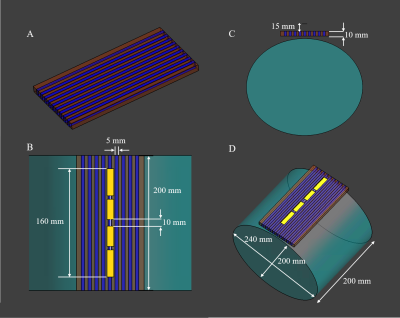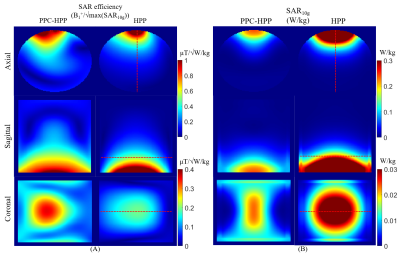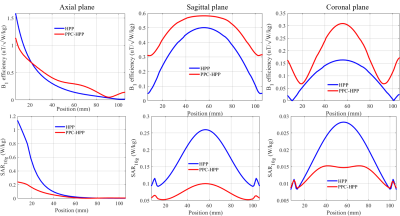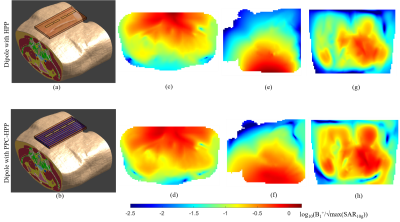3234
Combining High Permittivity Pads with Periodic Passive Components in RF Coil Design at 7T1the University of Queensland, Brisbane, Australia, 2Zhejiang University, Hangzhou, China
Synopsis
Periodic passive components (PPC) such as metamaterials can improve SAR efficiency and B1 penetration. However, due to the shorter RF wavelength in MRI, the performance of PPC is confined by the limited number of unit cells. In this work, a novel PPC structure has been proposed to combine with a high permittivity pad (HPP), so a larger number of unit cells can be used. The designed structure is excited by a dipole coil and compared with the case when a single HPP is used. It is observed that more than 50% SAR reduction can be achieved.
Synopsis
Periodic passive components (PPC) such as metamaterials can improve SAR efficiency and B1 penetration. However, due to the shorter RF wavelength in MRI, the performance of PPC is confined by the limited number of unit cells. In this work, a novel PPC structure has been proposed to combine with a high permittivity pad (HPP), so a larger number of unit cells can be used. The designed structure is excited by a dipole coil and compared with the case when a single HPP is used. It is observed that more than 50% SAR reduction can be achieved.Introduction
Passive components have been intensively researched and rapidly developed in MRI RF coil designs. Two types of passive components are particularly drawing more attention: the periodic passive components (PPC), e.g., metamaterials, and the high permittivity pad (HPP). Both PPC and HPP can be used to increase the $$$B_1^+$$$ penetration1,2 and reduce SAR2-5. While HPP has been proved to be effective under different field strengths3-5 (e.g., 1.5T, 3T, and 7T), PPC-based structures have shown enhanced performance with the increase of field strength6. Due to the features of the high dielectric constant of HPP, the RF wavelength inside HPP is significantly shortened, which implies that combining PPC and HPP can further augment the benefits from those two passive components. In this work, a novel PPC structure using multiple radiative rings has been proposed to be combined with an HPP. The proposed passive structure was excited by a dipole RF coil, and simulation results show that a significant reduction of SAR values can be achieved while maintaining reasonable $$$B_1^+$$$ penetrations.Methods
The proposed PPC-HPP structure is shown in Fig. 1. The PPC is composed of nine rectangular-shaped rings (Fig. 1A). Each ring is mounted on the surface of the HPP while the HPP is surrounded by nine rings (Fig. 1A). The PPC-HPP is excited by a dipole coil loaded with two inductors (Fig. 1B). The radiated $$$B_1^+$$$ field from dipole coil is redistributed by the PPC; thus, concentrated RF energy is dispensed into the phantom. Due to the high dielectric constant of HPP, the RF wavelength is significantly shortened within the HPP material, and consequently, the performance of PPC can be further improved. It is worth mentioning that the HPP can also reduce the SAR level and increase the $$$B_1^+$$$ penetration. Each PPC unit has a width of 5 mm and a length of 200 mm (the same length as the HPP). The space between each PPC unit is 5 mm. The HPP has a thickness of 10 mm and a dielectric constant of 120. The dipole has a length of 160 mm and a width of 10 mm. A 10 mm gap is placed at the center of the dipole as the feeding port. Two inductors with an inductance of 200 nH are used to shorten the dipole while tuning the dipole to resonate at 300 MHz. The distance between dipole coil and HPP is 15 mm (Fig. 1C). The proposed design is assessed using an elliptic cylinder with tissue-like properties ($$$\epsilon_r=35,\sigma=0.6 s/m$$$) (Fig. 1D) and a human voxel model “Duke” from the bio-model library of Sim4life (Zürich, Switzerland). The 10g-average peak local SAR and $$$B_1^+$$$ field are used to calculate the SAR efficiency as $$$B_1^{SAR}=B_1^+/\sqrt{max(SAR_{10g})}$$$. To verify the design concept of PPC-HPP, the same HPP without PPC and excited by the same dipole coil is used to compare with the PPC-HPP structure.Results and Discussion
Simulated SAR efficiency and SAR10g distribution in three orthogonal planes (axial, coronal, and sagittal) are shown in Fig. 2A-B. The $$$B_1^+$$$ field was normalized to 1W input power at the excitation port. It can be seen that the penetration with respect to SAR efficiency is improved by using a PPC-HPP structure compared with a single HPP. The SAR10g is significantly reduced, particularly in those regions close to the dipole. Fig. 3 shows line plots extracted from the dashed lines in Fig. 2. It can be seen that enhanced SAR efficiency can be achieved mainly in the deeper region of the phantom. It can also be observed that the SAR10g is reduced in the shallow region (i.e., the region where maximum SAR10g is typically present) of the phantom where the maximum local SAR10g is reduced from 1.16 W/kg to 0.24 W/kg that corresponds to 79% reduction. Over the Duke voxel model (Fig. 4), the PPC-HPP structure achieved higher SAR efficiency at all three planes than that of using a single HPP. The maximum local SAR10g of using PPC-HPP (0.32 W/kg) had a 51% reduction compared to the use of a single HPP (0.65 W/kg).Conclusion
A novel PPC structure combined with HPP was designed. Compared with the well-known HPP, SAR efficiency can be largely enhanced and the SAR10g can be significantly reduced more than 50%.Acknowledgements
No acknowledgement found.References
1. Freire MJ, Jelinek L, Marques R, Lapine M. On the applications of μr=-1 metamaterial lenses for magnetic resonance imaging. Journal of Magnetic Resonance. 2010 Mar 1;203(1):81-90.
2. Chen H, Guo L, Li M, Destruel A, Liu C, Weber E, Liu F, Crozier S. Metamaterial-Inspired Radiofrequency (RF) Shield With Reduced Specific Absorption Rate (SAR) and Improved Transmit Efficiency for UHF MRI. IEEE Transactions on Biomedical Engineering. 2020 Sep 9;68(4):1178-89.
3. Zivkovic I, Teeuwisse W, Slobozhanyuk A, Nenasheva E, Webb A. High permittivity ceramics improve the transmit field and receive efficiency of a commercial extremity coil at 1.5 Tesla. Journal of Magnetic Resonance. 2019 Feb 1;299:59-65.
4. Brink WM, Webb AG. High permittivity pads reduce specific absorption rate, improve B1 homogeneity, and increase contrast‐to‐noise ratio for functional cardiac MRI at 3 T. Magnetic resonance in medicine. 2014 Apr;71(4):1632-40.
5. Teeuwisse WM, Brink WM, Webb AG. Quantitative assessment of the effects of high‐permittivity pads in 7 Tesla MRI of the brain. Magnetic resonance in medicine. 2012 May;67(5):1285-93.
6. Algarín JM, Freire MJ, Breuer F, Behr VC. Metamaterial magnetoinductive lens performance as a function of field strength. Journal of Magnetic Resonance. 2014 Oct 1;247:9-14.
Figures

Fig. 1 A: The PPC is mounted and surrounds the HPP. B: The top view and dimensions of simulation configuration using an elliptic-cylinder phantom. C: The side view of modeling configuration. D: Three-dimensional view and dimensions of the elliptic-cylinder phantom.

Fig. 2 A: Simulated SAR efficiency distributions inside the phantom in three planes (axial, sagittal, and coronal). B: Simulated SAR10g distribution inside the phantom at three planes. The left column of A and B shows the results from using PPC combined with HPP, and the right column of A and B shows the results from using a single HPP.

Fig. 3. Line plots of SAR efficiency and SAR10g along the dashed lines shown in Figure 2. The selected lines at axial and coronal planes cross the center of the planes, and the selected line at the sagittal plane is 65 mm away from the top of the phantom
